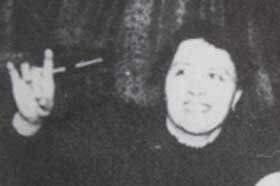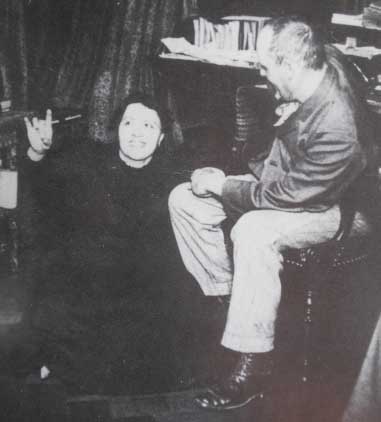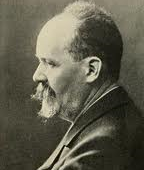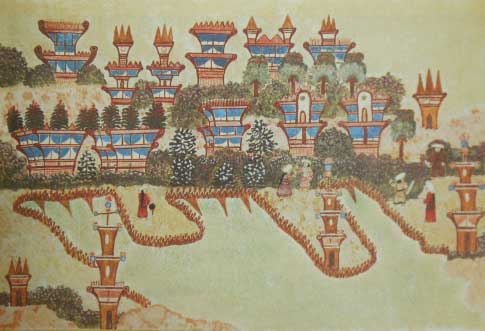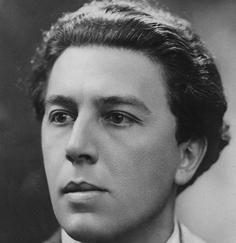Hélène Smith (1861–1929) was a Swiss medium, real name Catherine-Élise Muller, whose descriptions of ‘life on Mars’ and other trance visions were the subject of a detailed psychological study by Théodore Flournoy. Published in 1900, Des Indes à la Planèt Mars (From India to the Planet Mars), became a classic of psychology and psi research, and is often cited by proponents of non-paranormal and non-survivalist interpretations of mediumship. The complex phenomena of glossolalia (imaginary languages) in this case has also been of interest to linguists. Less well-known is Hélène Smith’s automatic painting, which inspired the work of surrealists such as André Breton.
Contents
Childhood and Youth
Catherine-Élise Muller was born in 1861 in Martigny, Switzerland, and lived in Geneva from childhood. Her father, a Hungarian trader, was versed in five different languages (Hungarian, French, German, Italian, and Spanish), and had some knowledge of another three (English, Latin, and Greek). These linguistic aptitudes were later considered by Flournoy to have contributed to Hélène’s ‘hereditary tendency’ to glossolalia.1Flournoy (1900), 15.
Both her father and her mother were Protestants, but Hélène was baptized in the Catholic Church. Her father was initially indifferent to Spiritism but later came to accept the doctrine of his daughter. Her mother, on the contrary, always had presentiments and visions, and these seemed to have facilitated the acceptance of the spiritist ideas. One of her brothers was also thought to have experiences characteristic of mediums.2Flournoy 1900; Piot-Mayol (2007).
During her childhood and youth, Hélène was accustomed to reveries and daydreaming. She was described as having a domestic and quiet temperament, and her moments of leisure were often dedicated to solitary activities. Hélène also reported visons since childhood (which Flournoy considered to be partially due to hypnagogic and hypnopompic phenomena), some of them involving coloured landscapes and other images that she would recognize, years later, as coincident with her purported visions of life in the planet Mars and other scenes from the spirit world. In her youth, she also often reported graphomotor hallucinations involving substitutions of French letters for strange and unknown characters. Flournoy recognized in these earlier tendencies and imaginary activities the beginnings of her trance romances and scenes depicting the life in the spirit world, as well as the rudiments of what would later become the Martian language (see below ‘Subliminal romances’).
In addition, Hélène mentioned the occurrence of what Flournoy later named as ‘teleological’ automatisms, that is, involuntary movements or impulses, sometimes accompanied by auditory or visual hallucinations, which seemed to protect her from diseases or danger. These automatisms would pave the way for the manifestations of Hélène’s spirit guide, Leopold, who later attributed part of these teleological phenomena to his several attempts to protect the medium from childhood.3Flournoy (1900).
At the age of thirteen, Hélène started working as a sales assistant in a silk store, where she remained for many years. She retired when, following the publication of Flournoy’s book, a north-American spiritualist and admirer offered her a salary to devote herself fully to her work as a medium.4Flournoy (1901); Deonna (1932).
Initiation into Spiritism
In September 1892, Hélène began to attend Spiritist seances and quickly started to present phenomena of automatisms, alterations of consciousness, and hallucinations. Flournoy categorized her mediumship at this stage as a triple phenomenon, involving visual and auditory modalities, as well as typological phenomena such as spirit-rapping, the phenomenon through which one supposedly communicates with the spirits by means of raps upon a table. These different modalities seemed to complement each other: while describing the apparitions and other images she perceived mentally, she could simultaneously obtain explanations by means of auditory hallucinations or raps heard on the table.
Hélène’s mediumistic communications usually involved moral admonitions, treatment prescriptions for the consultants, messages from deceased relatives and friends, and revelations of past lives of the participants of the séance. (She offered all these mediumistic services without remuneration, regarding her mediumship as a spiritual mission.)The messages always came with guidance of a spirit called Leopold, Hélène’s spiritual mentor, who claimed to have been Guiseppe Balsamo, the Count Cagliostro (an eighteenth century magician and occultist) in his last incarnation on Earth. Leopold intervened to explain obscure messages or scenes described by Hélène, or to offer advice on how participants should treat her when she presented unexpected behaviours or unusual trance states.
Flournoy first attended a séance given by Hélène on 9 December 1894, in response to an invitation by Auguste Lemaitre, a professor at the College of Geneva. To keep Élise’s identity confidential, Flournoy proposed the pseudonym Hélène Smith, partly after his three-year old daughter, Hélène Flournoy,5Piot-Mayol (2007). which the medium is said to have accepted the pseudonym after meeting the child.6Flournoy (1986).
In early seances, the medium provided a quantity of apparently true information concerning Flournoy’s family and relatives, including events that took place before he was born. Flournoy was later able to uncover a previous relationship between his family and that of the medium by which she could have obtained, perhaps subconsciously, at least part of the information. Accordingly, he interpreted these and other apparently supernormal phenomena as examples of cryptomnesia, a process in which past events or memories are seen by the individual as new experiences.
Personality and Mediumistic Phenomena
In terms of personality and general health, Flournoy saw Hélène as a healthy, intelligent and persevering woman. He also defined her as highly impressionable, and sensitive to the behaviours and attitudes of others. He was struck by her physical strength and tenacity, and her commitment to various activities besides her day job, noting that such characteristics contrasted with those of hysterics and people suffering from a mental health condition. Accordingly, he argued that mediumship should be understood in its own terms, not as an irrevocable manifestation of mental disease – as it was considered by many psychiatrists and psychologists of the time.7Alvarado et al (2007); Le Maléfan (1999).
Indeed, Hélène’s automatisms and ‘subliminal’ phenomena seemed to be more beneficial than detrimental to her, notably with regard to certain phenomena of hypermnesia (increased memory capacity), and presentiments regarding future events that later came true. In this sense, Flournoy differentiated between the automatisms of her daily life and those observed during spiritist seances. The latter were usually more intense, sometimes involving phenomena of catalepsy, lethargy, and the appearance of contractures. To evaluate Hélène’s mental states during seances, Flournoy conducted tests to measure her sensitivity to pain, her muscular force, and her hypnotisability.
By the time Flournoy started his study, Hélène’s mediumistic phenomena had become varied and complex, involving not only a partial state of trance, involving hallucinations and automatisms, but also a ‘total trance’ of which she could recall nothing once it had ended. The state also included complete personifications of discarnate spirits or personages from her previous lives. Although Flournoy refused to consider Hélène as a hysterical patient, he nevertheless found an association between some of Hélène’s mediumistic manifestations and the dissociative symptoms and psychomotor alterations observed in hysteria and individuals under hypnosis.
Hélène also developed a series of complex narratives – what he called ‘subliminal romances’ – related to previous lives or life in other planets, involving phenomena such as glossolalia and mediumistic painting.
Subliminal Romances
After five years, Flournoy categorized his investigations into three main cycles, or ‘romances’: the Martian cycle, the Hindu cycle, and the Royal cycle.
The Martian cycle comprised a series of visions of landscapes of Mars, as well as descriptions (later represented through drawings) of what the medium considered to be its inhabitants, its vegetation, and other forms of life. Some of the mediumistic communications of this cycle also emerged in a strange language, allegedly the idiom of Martians. The Martian language could appear to Hélène in the forms of auditory hallucinations (for example, voices, conversations), incomprehensible utterances and vocalizations, visions depicting the peculiar symbols that constituted the Martian alphabet, and semi-automatic handwritings.
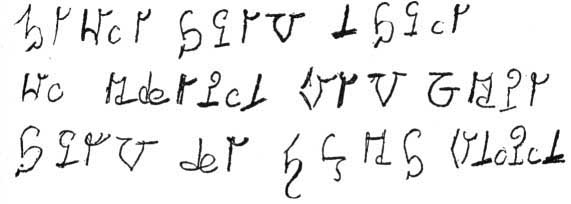
Above: Example of the ‘Martian’ text received automatically by Hélène Smith
It took some time for Flournoy to uncover its structure and provide a coherent translation into French. He was helped by Ferdinand de Saussure, a Swiss linguist with whom he corresponded frequently.8Flournoy (1986). Saussure held that Hélène’s Martian idiom was not a simple form of glossolalia, but a distinct language, one strongly derived from French idiom: each Martian letter corresponded to a French letter, and other grammatical similarities were found. In sum, the supposed Martian idiom could be considered a peculiar and imaginary imitation or reconstruction of French.
The medium then came up with a new language, which Flournoy classified as part of the ‘Ultra-Martian cycle’: a related narrative involving a planet said to be farther than Mars. The Ultra-Martian language was more complex; ultra-Martian inhabitants were more grotesque than those of Mars, which Flournoy interpreted as an unconscious response on the part of Hélène to his scepticism towards her naïve descriptions of the beauty of life on Mars. For Flournoy, these phenomena all confirmed the decisive role played by suggestion and expectation.9Alvarado et al (2014).
In the Hindu or Oriental romance – partly appearing at the same time as the Martian cycle – Hélène claimed to be the reincarnation of an Indian princess named Simandini. Simandini had a spouse called Sivrouka, supposedly one of Flournoy’s previous incarnations on Earth. The manifestations were too fragmentary to give a complete picture of the relationship, but Hélène’s representation of romantic scenes between the two were so vivid that Flournoy considered them on a par with what ‘the best actress could achieve only from prolonged studies or a stay on the banks of the Ganges’.10Flournoy (1900), 272.
As Simandini, Hélène could speak some Sanskrit and produce texts in Arabic script, though claiming to have no knowledge of these languages. Flournoy later identified potential sources that could have served in the elaboration of the key features of the Hindu cycle, as well as in her reconstruction of the Sanskrit. However, these were for the most part obscure or difficult to access, and it was far from certain that she could have come across them. Flournoy considered the Hindu language and other apparently veridical aspects of the Oriental cycle as ‘psychological enigmas’,11Flournoy (1900), 257. while theorizing that the sanskritoid idiom was a mixture of improvisations and authentic Sanskrit words buried in her latent memories.
The Royal cycle was concerned with Hélène’s supposed incarnation as Marie Antoinette, Queen of France. Here too, Hélène’s representations were vivid and detailed, and mirrored many of the queen’s known characteristics and behaviours. But there were virtually no similarities between the two women’s signatures (as was also the case with ‘Leopold’ and the real life Cagliostro that he claimed to have been).
Based on the analyses of these subliminal romances, Flournoy proposed psychological hypotheses to explain the case. His main theoretical reference was Frederic Myers’s ‘subliminal psychology’, which he combined with the French psychiatry of the time and the emerging field of psychoanalysis.12Alvarado et al (2014); Goldsmith (1979); Shamdasani (1994). For him, Hélène’s romances were products of a subliminal imagination, their content based on her previous memories and experiences, incubated and creatively combined in the subliminal regions of her mind. The romances, he considered, had an infantile character corresponding to a regression to earlier stages of the psychological development. However, he did not necessarily consider them by-products of pathological processes, more as adaptive elaborations that helped her deal with the frustrations of her life, better explained as ordinary psychological processes than in terms of Spiritist ideas. However, he conceded that part of the veridical information provided during the seances could be explained in terms of telepathy and clairvoyance – see below, ‘Parapsychological phenomena’.
Repercussions of Des Indes
Des Indes à la Planèt Mars achieved remarkable success and was praised by leading psychologists of the time. William James called it ‘the decisive step in converting psychical research into a respectable science’.13Le Clair (1966), 90-91. Despite the criticisms of some spiritualists and researchers,14Alvarado & Zingrone (2015). the book became a milestone in the psychological study of mediumship and dissociative phenomena.15Ellenberger (1979); Shamdasani (1994).
But the book had a strongly negative impact on Flournoy’s relationship with Hélène. As one might expect, the medium objected to many of his views regarding the imaginary origin of her mediumship.16Flournoy (1901). They engaged in a dispute over royalties, which ended with Flournoy giving half to her, and the other half to the journal Archives de Psychologie, which he founded and edited.17Deonna (1932); Flournoy (1986); Shamdasani (1994). The medium expressed resentment at the embarrassment she suffered from the negative and stereotyped evaluations she was subjected to in some news magazines and journals. Flournoy replied to some of these criticisms, in defence of Hélène.18Flournoy (1901).
Two years after publication, Flournoy published an article summarizing some of Hélène’s recent mediumistic manifestations, based on reports from Lemaitre and other participants. These involved new extra-terrestrial romances, now concerning life on the Moon and the planet Uranus, which Flournoy ascribed to the same psychological explanations as before.19Flournoy (1901).
Later Work
Hélène sought refuge from notoriety in her paintings, gradually isolating herself from the world. She began to report visions of Jesus Christ, who gradually supplanted Leopold as her protective guide. It has been suggested that her withdrawal might have been avoided, had Flournoy treated her case therapeutically, and not just analytically.20Goldsmith (1979).
The breakdown of the relationship appeared to be reflected in the medium’s subsequent manifestations, as Flournoy himself acknowledged.21Flournoy (1901). In later years Hélène felt persecuted by Flournoy and thought he was spying on her.22Deonna (1932), 52.She blamed her abandonment of mediumistic seances on his previous interference, apparently as a means to free herself from his influence. Eventually, she renounced her belief in the events of the Martian and Hindu cycle, but nonetheless remained a spiritualist, and continued to believe she had been Marie Antoinette in a previous incarnation.23Deonna (1932); Shamdasani (1994).
In this later phase, Hélène dedicated herself mainly to religious paintings, such as portraits of Christ and the Virgin. Lemaitre observed that the motivation underlying this new ‘religious cycle’ was probably the disease and death of her mother. These events may have produced in her a ‘painful crisis’,24Lemaitre (1907), 70 for which her religious experiences and artistic productions seemed to provide some consolation.
Psi Phenomena
Despite Flournoy’s belief that most of Hélène Smith’s phenomena could be explained in terms of psychological processes, he thought it possible that Hélène demonstrated genuine supernormal abilities. In a discussion in Des Indes, he expresses scepticism of the psychokinetic phenomena he witnessed such as apports and movement of objects without contact, considering the evidence weak and susceptible of mundane explanations, but nevertheless considers that she might in some cases have provided evidence of spontaneous clairvoyance and telepathic impressions.25Flournoy (1900), 373. However, he continued to deny that her mediumistic or ‘spirit’ messages required explanation in terms of supernormal abilities or spirit intervention.
Other researchers took issue with Flournoy’s conclusions. Charles Richet, for one, argued that Hélène’s knowledge of Sanskrit could not be simply explained in terms of cryptomnesia.26Richet (1922). For instance, Flournoy argued that Hélène might at some point have looked at a Sanskrit grammar book owned by a person in whose house she carried out some séances, a hypothesis Richet considered untenable: the medium, in his view, would scarcely have time during the séances to study the book and learn a whole new language. But Flournoy also had defenders: decades later, the Indian philosopher and parapsychologist Chari argued that Hélène probably knew some genuine Sanskrit words, although other aspects of her Sanskritoid language were a creation of her subconscious.27Chari (1963).
In Hélène’s later phase, following publication of Des Indes, she claimed to see balls of light that expanded and filled the room. She even tried to obtain photographic records of the supposed luminous phenomena related to her religious and artistic works, but the photographic plates were considered of little scientific value, having been produced by the medium herself, and lacking experimental control.28Deonna (1932).
Implications for Other Research
Besides its importance to the emerging psychology and psychical research of the time, the influence of the Hélène Smith case was also felt in other areas, notably by figures in the surrealist movement such as André Breton.29Rosemont (1998).Breton had a great appreciation for Hélène and her mediumistic manifestations, considering hers the most important case of mediumship.30Breton (1930; 1933). He also based the central character of his novel Nadja on her.31Breton (1928). (He was initially more familiar with the work of Frederic Myers, Théodore Flournoy and Pierre Janet than with Freud’s works;32Gibson (1987); Spinari-Pollalis (2001).he did not know German, and Freud’s books only began to be translated into French after 1921, by which time he had read Des Indes.) However, although Breton himself practised automatic writing, he was firmly convinced of the impossibility of communication between the living and the dead.33Ellenberger (1979).
Some authors suggest that Hélène’s ability with mediumistic painting was due to an earlier artistic interest. In this sense, her dedication to artistic mediumship in later life was only a pretext for what would be the full-time expression of her artistic gifts.34Claparède (1932); Lemaitre (1907). Such tendencies were already noted in the dramatic expressiveness of her trance performances, and in her interest in music. Hélène donated some of her paintings to a museum in Geneva, and after her death, on 29 June 1929, they were exhibited in Geneva and Paris. However, Waldemar Deonna, director of the Museum of Art and History of Geneva, did not consider mediumistic paintings to be of significant aesthetic value, although he acknowledged their psychological importance.35Deonna (1932).
Hélène Smith’s case also impacted the relations between psychology and linguistics. Scholars such as Engels, Cifali and Rosenberg36Engels (2008); Cifali (1988; 1994); Rosenberg (2000). investigated the curious phenomenon of glossolalia observed by Flournoy, in which dissociative and subconscious processes interacted to produce idiosyncratic and imaginary languages.
Victor Henry dedicated a whole book to the analysis of Hélène’s Martian Language.37Henry (1901). He argued that the creation of the Martian followed some of the same processes involved in the emergence of natural languages, and compared it to vocabularies around the world. In his turn, Engels suggested that German, of which she had some basic knowledge, also influenced the construction of the Martian idiom.38Engels (2008).
Cifali and Rosenberg emphasized the importance of expectations, notably Flournoy’s insistence on deciphering the structure of the Martian language, as crucial factors in Hélène’s imaginary creations.39Cifali (1994); Rosenberg (2000). In their view, Flournoy’s presence played an important part in the séances, as well as the character of Lemaitre’s notes. Flournoy constantly interrupts the usual rhythm of mediumistic activities, asking innumerable questions of medium and Leopold. Cifalli believes that this process of stimulating the medium to speak and translate her subliminal languages – not without resistance or fatigue on her side – could be conceived as a form of learning process. Without realizing it, Flournoy was helping Hélène to overcome boredom and fatigue, and to gradually to extend her various idioms.
Concluding Remarks
Hélène Smith illustrates the influence that exemplary cases may have on the development of research programs, especially for its implications for the then-emerging fields of psychical research and dynamic psychiatry, both deeply interconnected with the spiritualist beliefs of the time.40Maraldi et al (2016). As argued by Shamdasani,41Shamdasani (2003). a substantial part of the history of scientific studies on the unconscious and dreams has been neglected and distorted since the early decades of the twentieth century.
At a time when scientific psychology was in its infancy, Hélène Smith figured strongly in psychological discussions about the unconscious, yet this is seldom mentioned in official histories. Her case still holds implications for topics such as unconscious plagiarism, dissociative experiences, false memories, creativity, and glossolalia. It also has implications for parapsychology, especially concerning psychological explanations of apparently paranormal experiences, and the investigation of anomalous cognition reported by mediums.
Everton de Oliveira Maraldi
Literature
Alvarado, C.S., Machado, F.R., Zangari, W., & Zingrone, N.L. (2007). Perspectivas históricas da influência da mediunidade na construção de idéias psicológicas e psiquiátricas. Revista de Psiquiatria Clínica 34, 42-53.
Alvarado, C.S., Maraldi, E.O., Machado, F.R., & Zangari, W. (2014). Théodore Flournoy’s contributions to psychical research. Journal of the Society for Psychical Research 78, 149-68.
Alvarado, C.S., & Zingrone, N.L. (2015). Note on the reception of Théodore Flournoy’s Des Indes à la Planète Mars. Journal of the Society for Psychical Research 79, 156–64.
Breton, A. (1928). Nadja. Paris: Éditions Gallimard, 1998.
Breton, A. (1930). Second manifesto of Surrealism. In Manifestoes of Surrealism. Ann Arbor, Michigan, USA: The University of Michigan Press.
Breton, A. (1933/1998). The automatic message. In The Automatic Message, the Magnetic Fields, the Immaculate Conception. Soupault, UK: Atlas Press.
Chari, C.T.K. (1963). Recent research into Hélène’s ‘Hindoo cycle’. In From India to the Planet Mars, by T. Flournoy. New York: University Books.
Cifali, M. (1988). La fabrication du martien: genèse d’une langue imaginaire. Langages, 23/91, 39-60.
Cifali, M. (1994). The making of Martian: The creation of an imaginary language. In From India to the Planet Mars, by T. Flournoy. Princeton, New Jersey, USA: Princeton University Press.
Claparède, E. (1921). Théodore Flournoy: sa vie et son oeuvre. Archives de Psychologie 18, 1-125.
Claparède, E. (1932). Review of De la Planete Mars en Terre sainte. Archives de Psychologie 23, 376.
Deonna, W. (1932). De la Planète Mars en Terre Sainte: Art et subconscient. Paris: Boccard.
Ellenberger, H. (1970). The discovery of the unconscious: the history and evolution of dynamic psychiatry. New York: Basic Books.
Engels, H. (2008). Understanding the glossolalia of Hélène Smith, the famous spiritist medium. Psychiatries dans l’histoire: psychiatries in history, actes du 6 congrès de l’Association Européenne de L’histoire de la Psychiatrie. Caen, França: Universitaires de Caen.
Flournoy, O. (1986). Théodore et Leopold: de Théodore Flournoy a la psychoanalyse. Neuchstel, Suíça: La Baconniere.
Flournoy, T. (1900). Des Indes à la Planète Mars: étude sur un cas de somnambulisme avec glossolalie. Paris: Félix Alcan.
Flournoy, T. (1901). Nouvelles observations sur un cas de somnambulisme avec glossolalie. Archives de Psychologie 1, 101-255.
Gibson, J. (1987). Surrealism before Freud: Dynamic psychiatry’s ‘Simple Recording Instrument’. Art Journal 46.
Goldsmith, R.E. (1979). The Life and Work of Theodore Flournoy, 1854-1920. Tese de Doutorado, Michigan State University, East Lansing, Michigan, USA.
Henry, V. (1901). Le language Martien: Etude analytique d’une langue dans un cas de glossolalie somnambulique. Paris: J. Maisonneuve.
Le Clair, R.C. (1966). The Letters of William James and Théodore Flournoy. Madison, Wisconsin, USA: The University of Wisconsin Press.
Lemaitre, A. (1907). Un nouveau cycle somnambulique de Mlle Smith: ses peintures religieuses. Archives de Psychologie 7, 63-83.
Le Maléfan, P. (1999). Folie et Spiritisme: Histoire du Discours Psychopathologique sur la Pratique du Spiritisme, ses Abords et ses Avatars (1850–1950). Paris: L’Harmattan
Maraldi, E.O., Alvarado, C.S., Zangari, W., & Machado, F.R. (2016). Dissociação, crença e criatividade: uma introdução ao pensamento de Théodore Flournoy. Memorandum 30, 12-37.
Piot-Mayol, G. (2007). Il était une fois Hélène Smith. Genève 1895. Essaim 18, 133-46.
Rosemont, P. (1998). Surrealist Women. Austin, Texas, USA: University of Texas Press.
Rosenberg, D. (2000). Speaking Martian. Cabinet 1.
Richet, C. (1922). Traité de Mètapsychique. Paris: Félix Alcan.
Shamdasani, S. (2003). Jung and the Making of Modern Psychology: The Dream of a Science. Cambridge, UK: Cambridge University Press.
Shamdasani, S. (1994). Encountering Hélène: Théodore Flournoy and the genesis of subliminal psychology. In From India to the Planet Mars: A case of multiple personality with imaginary languages by T. Flournoy. Princeton, Estados Unidos da América: Princeton University.
Spinari-Pollalis, T. (2001). André Breton: Psychiatry in the Service of Surrealism. Doctoral thesis (Graduate School of Arts and Sciences). Boston, Massachusetts, USA: University of Boston.
